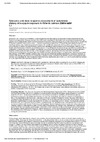Please use this identifier to cite or link to this item:
https://accedacris.ulpgc.es/jspui/handle/10553/55078
| DC Field | Value | Language |
|---|---|---|
| dc.contributor.author | Bernhard, Annette | en_US |
| dc.contributor.author | Rasinger, Josef D. | en_US |
| dc.contributor.author | Betancor, Monica B. | en_US |
| dc.contributor.author | Caballero, Maria José | en_US |
| dc.contributor.author | Berntssen, Marc H.G. | en_US |
| dc.contributor.author | Lundebye, Anne Katrine | en_US |
| dc.contributor.author | Ørnsrud, Robin | en_US |
| dc.date.accessioned | 2019-02-18T16:25:22Z | - |
| dc.date.available | 2019-02-18T16:25:22Z | - |
| dc.date.issued | 2019 | en_US |
| dc.identifier.issn | 1932-6203 | en_US |
| dc.identifier.other | WoS | - |
| dc.identifier.uri | https://accedacris.ulpgc.es/handle/10553/55078 | - |
| dc.description.abstract | Ethoxyquin (EQ; 6-Ethoxy-2,2,4-trimethyl-1,2-dihydroquinoline) has been used as an antioxidant in feed components for pets, livestock and aquaculture. However, possible risks of EQ used in aquafeed for fish health have not yet been characterized. The present study investigated the toxicity and dose-response of subchronic dietary EQ exposure at doses ranging from 41 to 9666 mg EQ/kg feed in Atlantic salmon (Salmo salar L.). Feed at concentrations higher than 1173 mg EQ/kg were rejected by the fish, resulting in reduced feed intake and growth performance. No mortality was observed in fish exposed to any of the doses. A multi-omic screening of metabolome and proteome in salmon liver indicated an effect of dietary EQ on bioenergetics pathways and hepatic redox homeostasis in fish fed concentrations above 119 mg EQ/kg feed. Increased energy expenditure associated with an upregulation of hepatic fatty acid beta-oxidation and induction and carbohydrate catabolic pathways resulted in a dose- dependent depletion of intracytoplasmic lipid vacuoles in liver histological sections, decreasing whole body lipid levels and altered purine/pyrimidine metabolism. Increased GSH and TBARS in the liver indicated a state of oxidative stress, which was associated with activation of the NRF2-mediated oxidative stress response and glutathione-mediated detoxification processes. However, no oxidative DNA damage was observed. As manifestation of altered energy metabolism, the depletion of liver intracytoplasmic lipid vacuoles was considered the critical endpoint for benchmark dose assessment, and a BMDL10 of 243 mg EQ/kg feed was derived as a safe upper limit of EQ exposure in Atlantic salmon. | en_US |
| dc.language | eng | en_US |
| dc.relation.ispartof | PLoS ONE | en_US |
| dc.source | Plos One [ISSN 1932-6203], v. 14 (1), (Enero 2019) | en_US |
| dc.subject.other | Synthetic Antioxidant Ethoxyquin | en_US |
| dc.subject.other | Fed Graded-Levels | en_US |
| dc.subject.other | Dna-Damage | en_US |
| dc.subject.other | Butylated Hydroxyanisole | en_US |
| dc.subject.other | Oxidative Stress | en_US |
| dc.subject.other | Glutathione | en_US |
| dc.subject.other | Metabolism | en_US |
| dc.subject.other | Expression | en_US |
| dc.subject.other | Growth | en_US |
| dc.subject.other | Biotransformation | en_US |
| dc.title | Tolerance and dose-response assessment of subchronic dietary ethoxyquin exposure in Atlantic salmon (Salmo salar L.) | en_US |
| dc.type | info:eu-repo/semantics/article | en_US |
| dc.type | Article | en_US |
| dc.identifier.doi | 10.1371/journal.pone.0211128 | en_US |
| dc.identifier.scopus | 85060521035 | - |
| dc.identifier.isi | 000457037500104 | - |
| dc.contributor.authorscopusid | 36930033900 | - |
| dc.contributor.authorscopusid | 55929492000 | - |
| dc.contributor.authorscopusid | 26431740800 | - |
| dc.contributor.authorscopusid | 57209992208 | - |
| dc.contributor.authorscopusid | 6603855136 | - |
| dc.contributor.authorscopusid | 6701639022 | - |
| dc.contributor.authorscopusid | 56117716100 | - |
| dc.identifier.issue | e0211128 | - |
| dc.relation.volume | 14 | en_US |
| dc.investigacion | Ciencias | en_US |
| dc.type2 | Artículo | en_US |
| dc.contributor.daisngid | 30362923 | - |
| dc.contributor.daisngid | 1685246 | - |
| dc.contributor.daisngid | 832465 | - |
| dc.contributor.daisngid | 436538 | - |
| dc.contributor.daisngid | 369981 | - |
| dc.contributor.daisngid | 359631 | - |
| dc.contributor.daisngid | 1361121 | - |
| dc.description.numberofpages | 36 | en_US |
| dc.utils.revision | Sí | en_US |
| dc.contributor.wosstandard | WOS:Bernhard, A | - |
| dc.contributor.wosstandard | WOS:Rasinger, JD | - |
| dc.contributor.wosstandard | WOS:Betancor, MB | - |
| dc.contributor.wosstandard | WOS:Caballero, MJ | - |
| dc.contributor.wosstandard | WOS:Berntssen, MHG | - |
| dc.contributor.wosstandard | WOS:Lundebye, AK | - |
| dc.contributor.wosstandard | WOS:Ornsrud, R | - |
| dc.date.coverdate | Enero 2019 | en_US |
| dc.identifier.ulpgc | Sí | es |
| dc.description.sjr | 1,1 | |
| dc.description.jcr | 2,776 | |
| dc.description.sjrq | Q1 | |
| dc.description.jcrq | Q2 | |
| dc.description.scie | SCIE | |
| dc.description.erihplus | ERIH PLUS | |
| item.grantfulltext | open | - |
| item.fulltext | Con texto completo | - |
| crisitem.author.dept | GIR IUSA-ONEHEALTH 3: Histología y Patología Veterinaria y Forense (Terrestre y Marina) | - |
| crisitem.author.dept | IU de Sanidad Animal y Seguridad Alimentaria | - |
| crisitem.author.dept | Departamento de Morfología | - |
| crisitem.author.orcid | 0000-0002-2575-0997 | - |
| crisitem.author.parentorg | IU de Sanidad Animal y Seguridad Alimentaria | - |
| crisitem.author.fullName | Caballero Cansino, María José | - |
| Appears in Collections: | Artículos | |
Items in accedaCRIS are protected by copyright, with all rights reserved, unless otherwise indicated.
